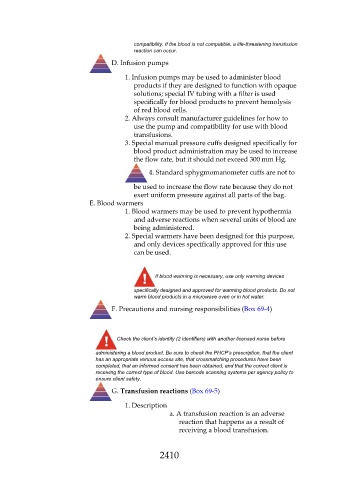Page 2410 - Saunders Comprehensive Review For NCLEX-RN
P. 2410
compatibility. If the blood is not compatible, a life-threatening transfusion
reaction can occur.
D. Infusion pumps
1. Infusion pumps may be used to administer blood
products if they are designed to function with opaque
solutions; special IV tubing with a filter is used
specifically for blood products to prevent hemolysis
of red blood cells.
2. Always consult manufacturer guidelines for how to
use the pump and compatibility for use with blood
transfusions.
3. Special manual pressure cuffs designed specifically for
blood product administration may be used to increase
the flow rate, but it should not exceed 300 mm Hg.
4. Standard sphygmomanometer cuffs are not to
be used to increase the flow rate because they do not
exert uniform pressure against all parts of the bag.
E. Blood warmers
1. Blood warmers may be used to prevent hypothermia
and adverse reactions when several units of blood are
being administered.
2. Special warmers have been designed for this purpose,
and only devices specifically approved for this use
can be used.
If blood warming is necessary, use only warming devices
specifically designed and approved for warming blood products. Do not
warm blood products in a microwave oven or in hot water.
F. Precautions and nursing responsibilities (Box 69-4)
Check the client’s identity (2 identifiers) with another licensed nurse before
administering a blood product. Be sure to check the PHCP’s prescription, that the client
has an appropriate venous access site, that crossmatching procedures have been
completed, that an informed consent has been obtained, and that the correct client is
receiving the correct type of blood. Use barcode scanning systems per agency policy to
ensure client safety.
G. Transfusion reactions (Box 69-5)
1. Description
a. A transfusion reaction is an adverse
reaction that happens as a result of
receiving a blood transfusion.
2410

